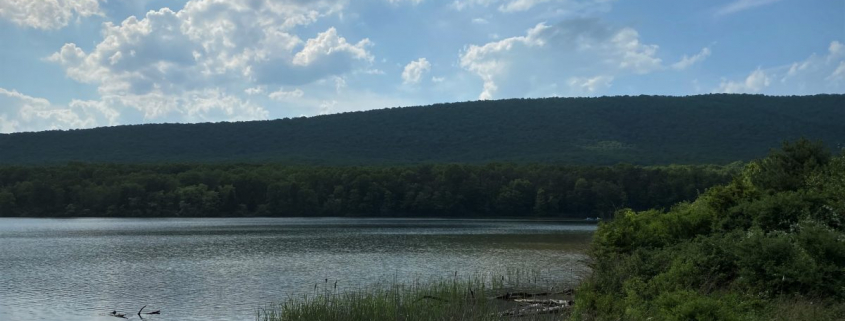Rocky Gap State Park Lake Habeeb Trail
Visiting with family occasionally takes me back to my central Appalachian hometown of Cumberland, Maryland. While there, regardless of season, I strive to visit one or more of my old Nature-haunts. May 25, 2021 I hiked the Lake Habeeb Trail at Rocky Gap State Park. Here are three prior Blog Posts from my September 2020 Rocky Gap wanderings:
- https://stevejonesgbh.com/2020/10/15/a-tough-hike-and-deep-reward-at-rocky-gap-state-park-in-western-maryland/
- https://stevejonesgbh.com/2020/10/21/september-2020-rocky-gap-state-park-central-appalachian-fall-flowers-ferns-and-fungi/
- https://stevejonesgbh.com/2020/10/28/the-intersection-of-human-and-natural-history-a-1766-survey-marker-above-rocky-gap-state-park/
There is something about retracing some of my younger-day outdoor adventures that fills my body, heart, mind, soul, and spirit.
Home Sweet Home
I begin with the these two photographs from a prior visit. A towering yellow poplar (below left) on the short hike with Alabama grandsons Sam and Jack up to the actual Rocky Gap overlook. I did not retrace that trail during my recent late May journey.
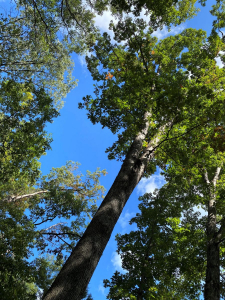
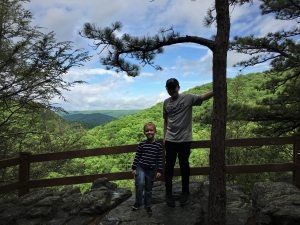
The 5.3-mile Lake Trail circuited the lake shore at approximately 1,100-feet elevation. Both scenes below view WNW to the nearly 2,200-foot Evitts Mountain. This is the scenery of my youth. I am a child of those ancient mountains…mountains whose spine reaches southwest into Alabama, where I now reside.
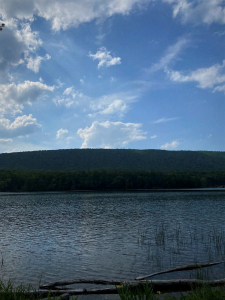
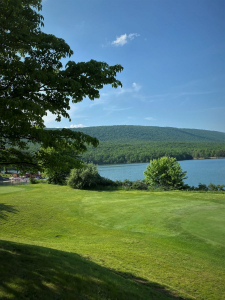
The memory-echoes from my youth reverberate deep within me when I range into our Alabama Appalachians. And, I literally trembled circuiting Lake Habeeb. Nature, especially home-nature, lifts me into a zone of comfort, peace, and serenity.
Trees
Allow me to introduce you to some of my old friends, tree species that welcome my return. They are not foreign to Alabama, yet they are far more common to my home region. Eastern hemlock grows abundantly streamside. I encountered it every time that the trail crossed a drainage way, with or without bridge crossing, along the route.
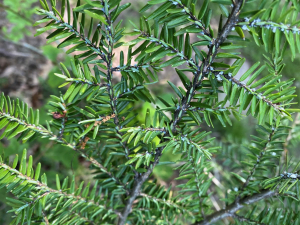
White pine is ubiquitous, along with Virginia and table mountain pines. Below left is an old agricultural field planted to white pine trailside. The close-up (right) is of white pine needles on a sapling growing along the western shoreline.
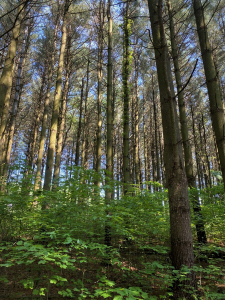
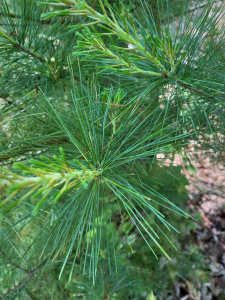
Sites along the circuit ranged from deep, moist, rich soils to shallow, shaley, xeric soils. Variability in site quality and species composition proved to be a constant. Always fascinated by tree form oddities and site variability, I regretted not allowing enough time to stroll more leisurely, to wander more purposely, and gather many more photographs. I could not resist spending a few minutes with this headless black cherry, arms raised high in praise and celebration. Of what I do not know. Black cherry on its favored soils and sites, can be a magnificent, high-quality timber tree, its thick straight trunks reaching well over a hundred feet skyward. This individual stands on a xeric upland among chestnut oak, a species common to these dry, nutritionally impoverished soils. Perhaps this denizen is simply celebrating life. What good does a forest citizen gain from a fat, straight trunk, with veneer quality logs? Is one such life more worthy than the other?
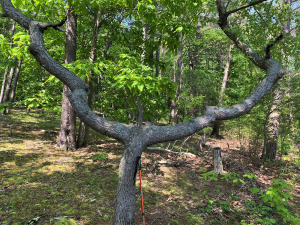
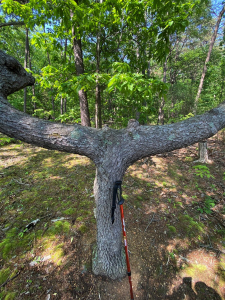
One need not have a doctoral degree in the relative site quality of soils derived from varying parent material, topography, and micro-climate to discern that this is a poor site, unfit for growing veneer quality black cherry!
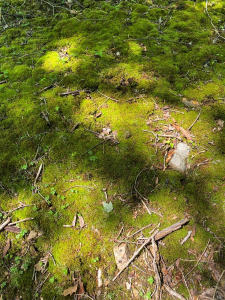
For every excellent sites there are impoverished areas, often distributed predictably across a single property. The best sites in northern Alabama and in the western Maryland Appalachians are alluvial zones and lower concave east and north facing slopes.
Native Shrubs in Flower
One of my lifetime favorites, mountain laurel, which ranges abundantly into northern Alabama, greeted me in soon-to-be full flower.
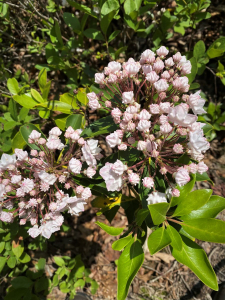
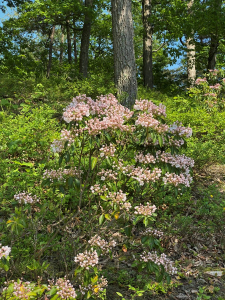
Winter berry likewise was entering its peak season. Not as showy as the laurel, winter berry still presented a strong statement along the way.
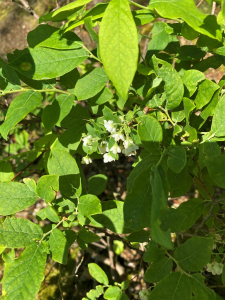
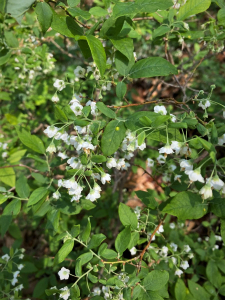
Blackberry competed for attention in forest edge zones receiving full sunlight. Were I to take this hike a couple of weeks later I might want to carry a basket for collecting its ripe fruit.
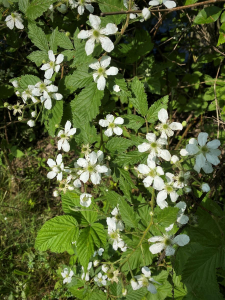
Common hawthorn also demanded floral appreciation. Ironic that such a fragrant and showy flower should grace a tree intent up puncturing those getting close with its long sharp thorns.
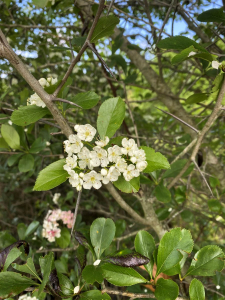
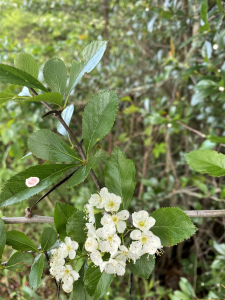
Even without its flowers, the white mulberry I encountered stopped me mid-step with its glossy oddly-lobed fresh spring leaves.
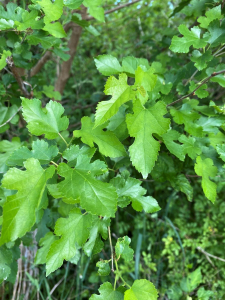
My iNaturalist identified this red-bristly-stemmed vine as wineberry. I’ve always called this invasive woody plant Japanese raspberry. Its red stem and deeply crenulated foliar surface attract attention.
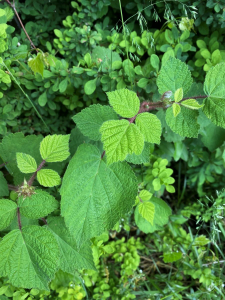
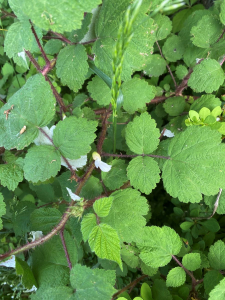
Spring Wildflowers
I found a few non-woody spring flowers worthy of mention. A favorite of mine, Jack-in-the-pulpit, makes my list, growing as abundantly and reliably in the mid-Atlantic states as here in northern Alabama.
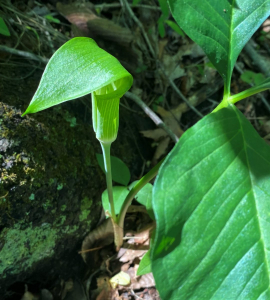
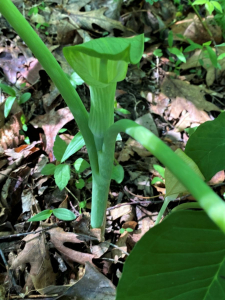
Along marshy edges of Lake Habeeb, yellow iris was a real show-stopper!
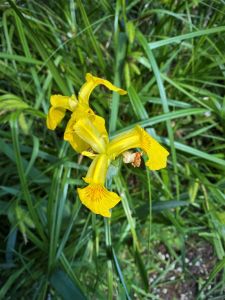
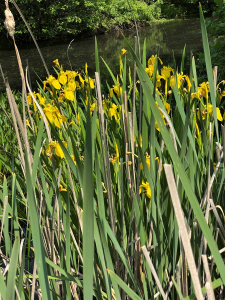
Every wild place I visit poses a dilemma for me. For example, how can I condense a 5.3-mile hike into a single Blog Post? How do I distill the tremendous variety of plants, sites, vistas, and reflections into a compelling tale? I suppose the answer begins with the photographs I snapped, screened, culled, and ultimately retained. As I select and order them, I draw my own observations, reflections, and sentiments. All of that translates into the text you eventually read.
This final photo is the overarching view, capturing some of my hike and holding within it at a much smaller scale the elements of site, trees, shrubs, and flowers presented above.
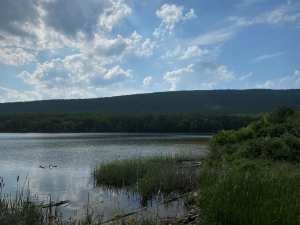
Thoughts and Reflections
I offer these observations:
- The Nature of my youth calls to me, and welcomes me back time and again.
- The natural places of my younger years touch places deep within me.
- Perhaps the strong homing is akin to what draws a salmon back to its birth headwaters.
Inhale and absorb Nature’s elixir. May Nature Inspire, Inform, and Reward you!
Note: All blog post images created & photographed by Stephen B. Jones unless otherwise noted. Please circulate images with photo credit: “©2021 Steve Jones, Great Blue Heron LLC. All Rights Reserved.”
Another Note: If you came to this post via a Facebook posting or by an another route, please sign up now (no cost… no obligation) to receive my Blog Post email alerts: http://eepurl.com/cKLJdL
And a Third: I am available for Nature-Inspired Speaking, Writing, and Consulting — contact me at steve.jones.0524@gmail.com
Reminder of my Personal and Professional Purpose, Passion, and Cause
If only more of us viewed our precious environment through the filters I employ. If only my mission and vision could be multiplied untold orders of magnitude:
Mission: Employ writing and speaking to educate, inspire, and enable readers and listeners to understand, appreciate, and enjoy Nature… and accept and practice Earth Stewardship.
Vision:
- People of all ages will pay greater attention to and engage more regularly with Nature… and will accept and practice informed and responsible Earth Stewardship.
- They will see their relationship to our natural world with new eyes… and will understand more clearly their Earth home.
Tagline/Motto: Steve (Great Blue Heron) encourages and seeks a better tomorrow through Nature-Inspired Living!
Steve’s Three Books
I wrote my books Nature Based Leadership (2016), Nature-Inspired Learning and Leading (2017), and Weaned Seals and Snowy Summits: Stories of Passion for Place and Everyday Nature (2019; co-authored with Dr. Jennifer Wilhoit) to encourage all citizens to recognize and appreciate that every lesson for living, learning, serving, and leading is either written indelibly in or is powerfully inspired by Nature.
I began writing books and Posts for several reasons:
- I love hiking and exploring in Nature
- I see images I want to (and do) capture with my trusty iPhone camera
- I enjoy explaining those images — an educator at heart
- I don’t play golf!
- I actually do love writing — it’s the hobby I never needed when my career consumed me
- Judy suggested my writing is in large measure my legacy to our two kids, our five grand kids, and all the unborn generations beyond
- And finally, perhaps my books and Blogs could reach beyond family and touch a few other lives… sow some seeds for the future


All three of my books (Nature Based Leadership; Nature-Inspired Learning and Leading; Weaned Seals and Snowy Summits) present compilations of personal experiences expressing my (and co-author Dr. Wilhoit for Weaned Seals and Snowy Summits) deep passion for Nature. All three books offer observations and reflections on my relationship to the natural world… and the broader implications for society. Order any and all from your local indie bookstore, or find them on IndieBound or other online sources such as Amazon and LifeRich.

